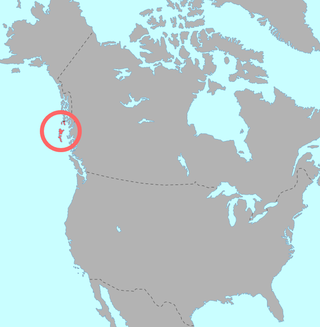
Back هيدا (لغه) ARZ Idioma haida AST ХӀайда мацӀ AV Haideg Breton Idioma haida Catalan Хайда (чĕлхе) CV Haida (Sprache) German Ĥajda lingvo Esperanto Idioma haida Spanish Haida keel Estonian
| Haida | |
|---|---|
| X̱aat Kíl, X̱aadas Kíl, X̱aayda Kil, Xaad kil | |
 A woman hangs posters with the Haida words for various body parts | |
| Native to | |
| Ethnicity | Haida people |
Native speakers | 13 (2018, 2020)[1] |
| Latin | |
| Official status | |
Official language in | |
| Language codes | |
| ISO 639-2 | hai |
| ISO 639-3 | hai – inclusive codeIndividual codes: hdn – Northern Haidahax – Southern Haida |
| Glottolog | haid1248 |
| ELP | Xaad Kil (Haida) |
 Pre-contact distribution of Haida | |
 Northern Haida is classified as Critically Endangered by the UNESCO Atlas of the World's Languages in Danger | |
| People | Haida |
|---|---|
| Language | Haida kil |
| Country | Haida Gwaii |
Haida /ˈhaɪdə/[2] (X̱aat Kíl, X̱aadas Kíl, X̱aayda Kil, Xaad kil[3]) is the language of the Haida people, spoken in the Haida Gwaii archipelago off the coast of Canada and on Prince of Wales Island in Alaska. An endangered language, Haida currently[when?] has 24 native speakers, though revitalization efforts are underway. At the time of the European arrival at Haida Gwaii in 1774, it is estimated that Haida speakers numbered about 15,000. Epidemics soon led to a drastic reduction in the Haida population, which became limited to three villages: Masset, Skidegate, and Hydaburg. Positive attitudes towards assimilation combined with the ban on speaking Haida in residential schools led to a sharp decline in the use of the Haida language among the Haida people, and today almost all ethnic Haida use English to communicate.
Classification of the Haida language is a matter of controversy, with some linguists placing it in the Na-Dené language family and others arguing that it is a language isolate. Haida itself is split between Northern and Southern dialects, which differ primarily in phonology. The Northern Haida dialects have developed pharyngeal consonants, typologically uncommon sounds which are also found in some of the nearby Salishan and Wakashan languages.
The Haida sound system includes ejective consonants, glottalized sonorants, contrastive vowel length, and phonemic tone. The nature of tone differs between the dialects, and in Alaskan Haida it is primarily a pitch accent system. Syllabic laterals appear in all dialects of Haida, but are only phonemic in Skidegate Haida. Extra vowels which are not present in Haida words occur in nonsense words in Haida songs. There are a number of systems for writing Haida using the Latin alphabet, each of which represents the sounds of Haida differently.
While in Haida nouns and verbs behave as clear word classes, adjectives form a subclass of verbs. Haida has only a few adpositions. Indo-European-type adjectives translate into verbs in Haida, for example 'láa "(to be) good", and English prepositional phrases are usually expressed with Haida "relational nouns", for instance Alaskan Haida dítkw 'side facing away from the beach, towards the woods'. Haida verbs are marked for tense, aspect, mood, and evidentiality, and person is marked by pronouns that are cliticized to the verb. Haida also has hundreds of classifiers. Haida has the rare direct-inverse verbal alignment where instead of nominal cases, it is marked whether the grammatical subject and object follow or not a hierarchy between persons and noun classes. Haida also has obligatory possession, where certain types of nouns cannot stand alone and require a possessor.
- ^ Haida at Ethnologue (25th ed., 2022)

Northern Haida at Ethnologue (25th ed., 2022)
Southern Haida at Ethnologue (25th ed., 2022)
- ^ Laurie Bauer, 2007, The Linguistics Student's Handbook, Edinburgh
- ^ Hume, Stephen (17 March 2014). "A high-tech fight to save B.C.'s indigenous languages". The Vancouver Sun.
© MMXXIII Rich X Search. We shall prevail. All rights reserved. Rich X Search